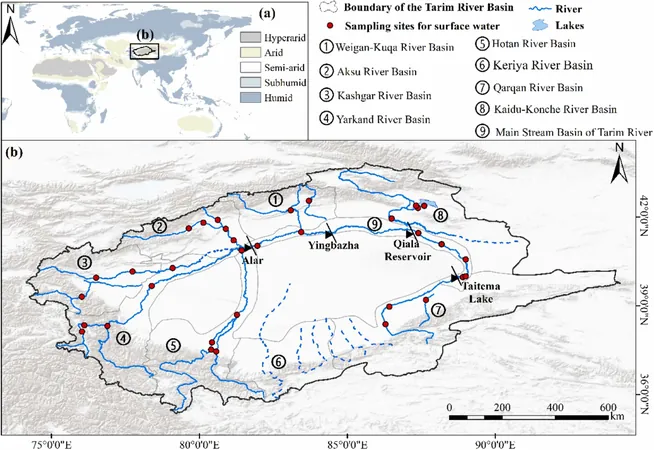
Unveiling the Hidden Dangers: Health Risks of Toxic Elements in China's Tarim River Basin
2024-11-21
Author: Wei
Introduction
In a groundbreaking study that could have significant implications for environmental health, researchers have turned their attention to potentially toxic elements (PTEs) present in the surface water of the Tarim River Basin in China. The findings, published in the journal Ecotoxicology and Environmental Safety, suggest that while the concentrations of some harmful elements are comparatively low, there are still serious concerns that could impact both the ecosystem and local populations.
Research Overview
Led by Professor Jilili Abuduwaili from the Xinjiang Institute of Ecology and Geography (XIEG), the research team meticulously collected surface water samples from 34 key locations throughout the Tarim River Basin. Their analysis focused on key PTEs, including arsenic (As), cobalt (Co), copper (Cu), and nickel (Ni).
Findings and Implications
Interestingly, when comparing the concentration levels of these PTEs in the Tarim River with those found in rivers globally, it was discovered that the Tarim River typically exhibited lower levels—except for arsenic, which posed a greater risk. Alarmingly, the highest levels of arsenic were detected upstream, raising red flags about the potential sources of contamination affecting the water quality.
While the study discovered elevated concentrations of copper, nickel, and cobalt in catchment areas, it also noted that these elements were found in much lower amounts in the high mountain regions upstream. This gradient hints at possible land-use impacts and industrial runoff, factors that are becoming increasingly critical in the discussions around water safety and environmental management in arid regions.
Health Risk Assessment
To assess the potential health implications for the local population, the researchers utilized Bayesian analysis techniques. Their findings were somewhat reassuring, revealing that the non-carcinogenic risks associated with exposure to these PTEs across four age cohorts—infants, children, adolescents, and adults—were deemed acceptable. However, this does not discount the need for continuous monitoring and management of water quality.
Conclusion
Li Yizhen, the study's first author, emphasized the importance of ongoing vigilance, particularly during the dry season when evapotranspiration rates can lead to significant fluctuations in the concentration of these toxic elements. “With rising temperatures and changing weather patterns, understanding how these factors influence water composition is crucial for safeguarding both health and the environment,” Li warned.
As the impacts of climate change become increasingly pronounced, the implications of this study are far-reaching, underlining the need for robust water management policies that protect both the community and the fragile ecosystems of the Tarim River Basin. The study aims to serve as a catalyst for further research and action towards improving water safety standards in vulnerable regions worldwide.
Call to Action
Stay tuned as we continue to investigate the water quality issues in arid areas like the Tarim River Basin, where the risks may be closer than we think!

 Brasil (PT)
Brasil (PT)
 Canada (EN)
Canada (EN)
 Chile (ES)
Chile (ES)
 España (ES)
España (ES)
 France (FR)
France (FR)
 Hong Kong (EN)
Hong Kong (EN)
 Italia (IT)
Italia (IT)
 日本 (JA)
日本 (JA)
 Magyarország (HU)
Magyarország (HU)
 Norge (NO)
Norge (NO)
 Polska (PL)
Polska (PL)
 Schweiz (DE)
Schweiz (DE)
 Singapore (EN)
Singapore (EN)
 Sverige (SV)
Sverige (SV)
 Suomi (FI)
Suomi (FI)
 Türkiye (TR)
Türkiye (TR)